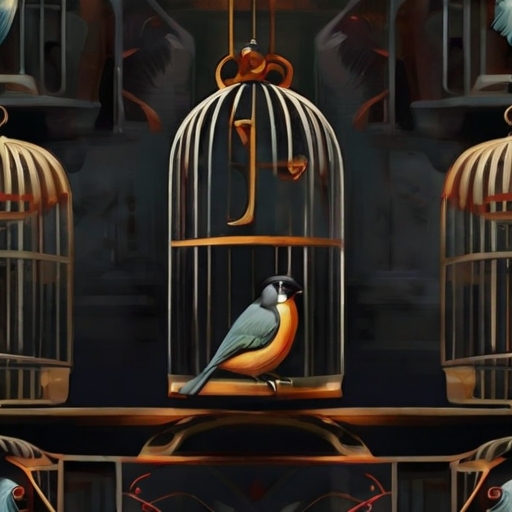
Caged Bird by Maya Angelou :Analysis
Here is the analysis of “Caged Bird by Maya Angelou. In this article, we present a critical interpretation of the poem and identify the existing literary devices deployed by the poet to communicate her meaning.
Maya Angelou was a poet and civil rights activist who was born in the late 1920s. She was respected as a spokesperson for black people in general and women in particular, and her works have been viewed as a defense of black culture in America.
The birds are a popular symbol in poetry, having been used by the Romantics as an expression of freedom and sometimes symbolizing poetry itself. Maya Angelou deviates from the norm by conveying the bird’s sorrow and rage as well as its freedom.
The caged bird represents the plight of Black Americans. Its song is a reference to how slaves in the nineteenth century gathered at Congo Square to sing in order to remember their heritage. The rage bars on the caged bird’s cage are supposed to represent the bird’s blinding rage at being imprisoned.
Summary of Cage Bird
In “Caged Bird,” poet Maya Angelou uses birds as an extended metaphor to convey the frustration and suffering of those who are oppressed.
Angelou first describes the joy that a free bird takes in soaring through the sky. She describes a bird that has been caged, its feet tied and wings clipped.
The caged bird rails against its imprisonment. In spite of its fear and rage, it sings of freedom.
Caged Bird Themes
The main themes in “Caged Bird” are freedom and confinement, artistic expression as resistance, and civil rights.
Freedom and Confinement
As its title indicates, “Caged Bird” is concerned with both imprisonment and the innate urge for freedom.
Artistic Expression as Resistance
Despite being confined, the caged bird’s song is able to extend far past his physical conditions, thus serving as an apt metaphor for artistic expression even under oppression.
Civil Rights
“Caged Bird” can be fruitfully read as a poem that expresses the ongoing need for equality, particularly for Black Americans.
READ ALSO:
- Song of a Girl Going to Bathe
- Writing Tips To Guide Your Writing Journey
- Life is a Place Where it’s Forbidden to Live
Caged Bird Characters
The main characters in “Caged Bird” are the free bird, the caged bird, and the speaker.
- The free bird lives a life of joy and ease, flying wherever he wishes and claiming ownership of the sky.
- The caged bird lives in captivity, with clipped wings and bound feet. Despite his anguish, he sings songs of freedom that reach far beyond his cage.
- The speaker is the poem’s third-person omniscient narrator. They place the greatest emphasis on the caged bird, conveying a sense of empathy for his plight.
Forms and Poetic Devices in Caged Bird
Angelou’s poetry is not governed by meter, rhyme, or stanza. She determines her own structure or lack thereof, and employs form and device for her own ends; she seeks the appropriate sound, tempo, rhythm, and rhyme for each line.
The unstructured verse is used in “Caged Bird.” The number of beats per line varies; for example, line 1 contains four beats, line 2 contains six, line 3 contains four, and line 4 contains five. The number of lines in each stanza varies; stanzas 1 and 2 each have seven lines, but stanzas 3 and 4 have eight.
Repetition
The repetition of the third stanza gives the poem some predictability and allows the reader to actively participate in the unfortunate plight of the caged bird.
Other parts of the poem, on the other hand, are unpredictable and even pleasurable; the joy of the free bird allows the reader to bear the tragic story of the oppressed one.
Personification
Angelou employs a variety of stylistic devices in her poem to effectively convey her message. Personification is used when she writes “his shadow shouts,” “the free bird names the sky,” and “the sailing bird rides on the back of the wind.”
In “Caged Bird,” she makes good use of imagery. Her adjectives help the reader see the “orange sun rays” and the “dawn-bright lawn” clearly.
Her precise verbs make the action in the verse clear. The free bird, for example, “leaps,” “dips his wing,” and “dares to claim the sky,” whereas the caged bird “stalks” and “can rarely see through/his bars.” Angelou depicts both the free bird’s dance and the hampered hobble of the caged bird.
Metaphor
One of Angelou’s most obvious stylistic devices is metaphor. The reader realizes that the caged bird represents Angelou, as well as any African American living in an oppressive society.
The perch in the confining cage is the “grave of dreams.”
READ ALSO:
- Daddy’s Little Girl 2 – Letter to Parents
- The Tortoise And The Feast in Heaven
- Why The Tortoise And The Squirrel Are Not Friends
We believe the above piece of information on Caged Bird by Maya Angelou was useful. Please, kindly share this content on all social media platforms.
